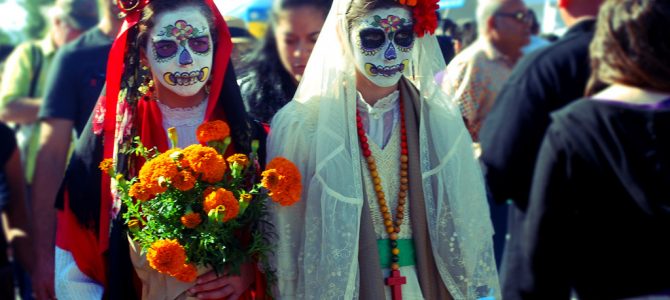
If you haven’t celebrated El Día de Los Muertos yet, you haven’t lived (or died)! Once upon a time in proto-Mexico, there were pre-Colombian, indigenous observances honoring the dead. Franciscans, Jesuits, and syncretism worked their magic, and eventually the Curia hatched a holiday for Mexican Catholics.
How holy is it, as holidays go? El Día de los Muertos definitely drives at the Christian belief in the resurrection of the body and the life everlasting. This is how the celebration landed a calendar date to make churchly sense of it: All Saints’ Eve on October 31, All Saints’ Day on November 1, and All Souls’ Day on November 2.
While the Day of the Dead is still mostly celebrated in Mexico and among people of Mexican descent in the United States and elsewhere, one doesn’t have to be Mexican or Roman Catholic to enjoy one of their finest contributions to the calendar. They’re really nice people—they will totally share their cool day! In fact, the local mercados and panaderías can only benefit from others seeing what a good thing they have going on.
Party Planning for The Day of the Dead
How often does a person see an altar with flickering candles, beautiful flowers, a statue of Blessed Mary, painted skeletons dressed up as Mariachi band members, a plate of enchiladas, and maybe even a bottle of Grandpa’s fave beer? If something can be outright funny without any ridicule of an actual serious thing, the Day of the Dead is it.
Bright paper banners hung from roof to roof are always cheery. Skulls are creepy—unless they aren’t! Craft them out of brightly colored sugar, and kids will literally eat them up. Honestly, would you rather have a plastic pumpkin filled with Smarties and Dum Dums, or a spooky candy skull? The choice is obvious.
Lilies are nice, and they have that resurrection trumpet thing going for them. But marigolds are brighter and prettier, and their name alone reminds us of the mother of our Lord. Autumnal colors point to the fact that winter is soon to follow. Seasonally and theologically speaking, grass withers and flowers fade. Marigolds are hardy, though. Put cut marigolds in a vase of water and they’ll make the Energizer bunny doubt his calling.
They’re also good at making a comeback: if you give shriveled marigolds some time in the ground, you might get to see the dead rise. Lots of people are allergic to lilies, but marigolds can still be served on airplanes and in school cafeterias all over the western hemisphere. After this paragraph, does anyone even buy lilies anymore?
Elaborate photo displays of the deceased are common at visitations and funerals. What happens with those meaningful collections afterwards? Why not save them and display them each year to celebrate the Day of the Dead? It might not be strictly cromulent to have large memorial photo spreads or slideshows displayed in a living room every day, but for one day it could be emotionally (if not spiritually) curative.
Cemetery Tailgating: ¿Por qué No?
El Día de los Muertos teaches the world about the authentic Christian fusion of sorrow and joy, grieving and partying. This is exactly what believers are called to when we are described as those who do not sorrow without hope.
Our own faces painted as skulls remind us that we are dust, and to dust we shall return. Cooking the favorite food of deceased loved ones affirms the resurrection of the body: their favorite food still matters, because they will be physically raised, complete with mouths, palates, and digestive tracts, when our Lord returns. Eternity involves feasting, and we look forward to that. The music of the day reflects on loss while it also captures the joy of knowing that what is gone now is not gone forever.
Christians believe that those who sleep shall be awakened. This is one of the main points of the Day of the Dead. The lights of the candles are meant to guide the dead back to their loved ones. The smell of their favorite food serves the same function, keeping them close to us through the wafting scents of delicious dishes. (Bonus: whatever isn’t eaten by the deceased goes to the bereaved on the last day of the celebration, unless you’re too fancy for leftovers.)
Also, cranky Protestants, these commendably incarnational ideas are no worse than the notion that a billion see-through grandpas are floating through our walls all the time, thinking that everything they see us doing is great.
Maybe the sugar skulls, marigolds, and lively guitar string plucking of the música folklórica can’t get it completely done for those who mourn—well, for a fact, they can’t. But they do lead us to reflect on and trust in the Lord’s sure promise that at his word the dead will rise. While no one knows the hour or the day, if Christ returns during a Day of the Dead celebration, it would show the rest of the world that Mexico knew what was up all along.
¡Viva México! ¡Vivan los muertos! ¡Long live the dead!









